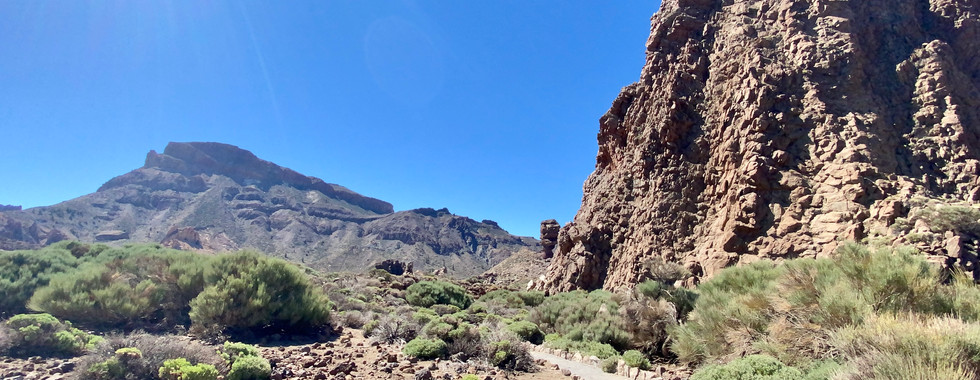El Teide National Park
- Michael_sgrant

- Jul 31, 2021
- 4 min read
From exploring lava fields to famous rock formations, to climbing the slopes of the volcano itself, El Teide National Park offers an abundance of spectacular scenery to discover...

On the slopes of the volcano: El Teide
Before you read this, make sure to check out my full blog on TENERIFE to see what I got up to before exploring El Teide National Park!
We set off early morning: the drive up to the volcano can take just as long (or even longer) than driving to the other end of the island, since the road has a lot of twists and turns. Drive up the walls of the Caldera and you are greeted with this incredible plateau, a vast landscape with its three-million-year-old lava flows and ancient rocks. If you take the highway TF-21 the first place you will encounter will be the Mirador de Boca Tauce, where you will suddenly find a huge lava field. You can just imagine the volcano erupting, lava spilling down the side of the volcano and hurdling along the ground...
You continue driving in this place and it is impossible not to stop every 5 seconds! Just up the road is another viewpoint...
ROQUES DE GARCIA:
One of the main attractions in El Teide National Park is Roques De Garcia, iconic rock formations just on the foothills of the volcano. Roque Cinchado is one of the most famous rock formations, it is so symbolic that it used to appear on some old bank notes - the structure stands 27m tall and features an interesting combination of earth hues that range from red and ochre, to copper and brown. Others include La Catedral and La Cascada, which have striking shapes, as well as smaller structures like El Torrotito, El Burro and Roque Blanco. Whilst you're here you can also hike an easy circular trail which covers 3.5km and takes approximately two hours.
Roques De Garcia
EL TEIDE VOLCANO:
Let me remind you that the volcano itself stands at 3,718m (12,188ft) tall, so it's no wonder why it takes between 6-7 hours to climb; however the easy option is to take the Teleferico. The 8 minute journey ascending 1,200m, by cable car, links the base station with La Rambleta, the upper station. Not only is it comfortable and fast, it is also an easy and fantastic way to visit the volcano and discover this natural treasure...

...The El Teide Cable Car’s lower station is easy to reach by road and stands at 2,356m above sea level. The cable car itself can hold a maximum of 44 passengers and travels to the top in under 8 minutes. The lower station includes a souvenir shop and a restaurant which offers spectacular views of El Teide National Park. At the top you are asked to come prepared for changes in temperature; located at 3,555m altitude, the upper station is the starting point for three marvellous routes:
Route No. 10 - Telesforo Bravo to the Crater of Mt Teide: This route takes you to Spain’s highest peak, from where you can enjoy one of the world’s most magnificent landscapes. On clear days, you can glimpse the nearby islands of La Gomera, El Hierro, La Palma and Gran Canaria. For environmental protection reasons, access to the peak is controlled and a permit is required to climb to the summit. Access is restricted to about 200 people per day so make sure you reserve at least a month or two in advance! Click the link to apply online for free: www.reservasparquesnacionales.es.
Route No. 11 - La Fortaleza Vantage Point: An incredible spot from where you can take in the spectacular view of the North side of Tenerife, including Valle de La Orotava in the centre and the long ridge of Monte La Esperanza that melds with the rugged Anaga Massif.
Route No. 12 - Pico Viejo Vantage Point: An awe-inspiring viewpoint overlooking South Tenerife and a perfect place from where to admire the great Caldera of Las Cañadas del Teide, its enclosure of sheer walls of rock and the aftermath of the last volcanic eruptions. You can also survey the multi-coloured crater of Pico Viejo, the rocky outcrops of Roques de García and Mt Guajara.
El Teide Cable Car is open from 09:00 to 17:00. Tickets for the cable car cost €37 for a return trip and can be found at: Buy Mount Teide Cable Car Tickets Online | Volcano Teide
On the peak of the volcano
In the past El Teide National Park was home to a supervolcano which collapsed forming the caldera that is currently sits in. The vast landscape that you see consisted of a huge volcano which has long since disappeared. The 'Las Cañadas' Caldera was formed around 170,000 years ago when a massive landslide resulted in the disappearance of the top of the island. The landslide left behind a huge depression open to the sea and covered the ocean floor with a chaos of rocks. Subsequently, reactivation of volcanic activity cause the Teide and Pico Viejo volcanoes to emerge in the interior of Las Cañadas. At the peak of El Teide you can see the many lava flows which were a result of the eruptions of Montaña Rajada, Montaña Blanca, Pico Viejo, as well as the original crater of El Teide. The caldera which is now formed measures 15km in diameter making it one of the largest calderas in the world, as it continued being filled with material produced by various volcanic eruptions through the years.

Map of El Teide National Park featuring: the TF-21 highway, Roques de Garcia, El Teleferico, Pico Viejo, Las Cañadas, and El Teide itself

Descending back down, there are many other places to see around the base of the volcano. You can take a stroll through Las Cañadas Del Teide, and walk through landscapes that really make you feel like you're walking on Mars (as pictured). This exact location is a place called Minas de San Jose. An alternative option may be just simply driving through on the TF-21 highway, the views there are incredible!
So as you can see, there are many things to see and do in El Teide National Park - be prepared to spend the entire day there! Remember if you're interested in seeing what else I got up to, check out my TENERIFE blog to find out more!
See you next time!















































Comments